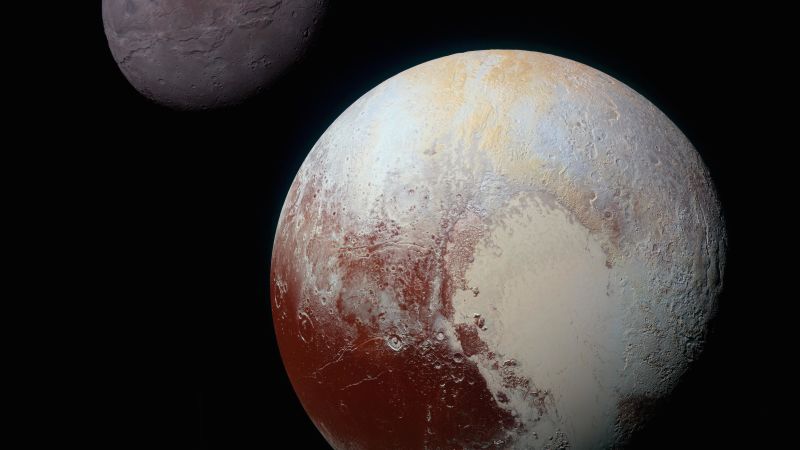The origins of Pluto’s large moon, Charon, have long puzzled astronomers. Various theories have been proposed to explain how Charon came to be so large in comparison to Pluto, with some suggesting that it formed as a result of a massive collision similar to the way Earth’s moon was created. Recent research has introduced a groundbreaking concept referred to as “kiss and capture,” proposing that billions of years ago, Pluto and Charon briefly combined during a collision before separating again, retaining a gravitational bond.
This new study challenges earlier hypotheses that compared Charon’s origins to those of Earth’s moon, which formed after a Mars-sized body impacted our planet, resulting in debris coalescing to create a lunar orbiter. However, the study’s lead author, Adeene Denton, highlighted that such models did not consider the unique physical properties of Pluto and Charon, noting that both celestial bodies are significantly smaller, colder, and primarily composed of rock and ice, distinct from larger planetary bodies in the solar system.
According to the researchers, rather than merging permanently upon impact, Pluto and Charon likely maintained their structural integrity, creating a temporary cosmic form before evolving into their current binary relationship. This scenario contrasts with conventional models of planetary collisions, typically categorized as “hit and run” or “graze and merge.” Denton elucidated that their findings reveal a novel impact type where the two bodies collide, momentarily stick together, and then separate, yet remain gravitationally bound.
The implications of this finding extend beyond the Pluto-Charon system, potentially shedding light on the formation and evolution of planets throughout the solar system. Furthermore, this study offers new insights into the presence of a subsurface ocean beneath Pluto’s icy crust. The unique dynamic between Pluto and Charon is intriguing, particularly as they both represent significant sizes compared to their primary body—an anomaly among the moon systems in our solar system where smaller moons orbit larger planets.
For comparison, the Martian moons Phobos and Deimos exemplify smaller, irregularly shaped bodies likely captured by gravitational forces rather than formed from collision scenarios. As the research delves deeper, it becomes apparent that the kiss-and-capture model posits a more plausible explanation of how larger bodies like Charon could form, emphasizing the distinct physical dynamics at play in such cosmic interactions.
Denton further explains that analyzing the interactions based on material strength provides a more coherent model than previous simulations from the early 2000s, which oversimplified the collision dynamics by treating the colliding materials as fluid. As the research progressed and simulations grew more sophisticated, it was possible to incorporate the structural properties of Pluto and Charon, allowing scientists to closely assess the exchange of momentum during collisions.
The research proposes that during the impact, while some material may have exchanged between Pluto and Charon, the bodies remained largely intact. They formed a transient shape reminiscent of a “cosmic snowman,” eventually resulting in Charon being pushed into a more distant orbit over time due to Pluto’s gravitational pull.
Denton remarked on the surprising nature of the “kiss” aspect in this collision theory, indicating that previous models had never presented a scenario in which two celestial bodies temporarily merged before re-separation. The findings suggest that Charon may be as ancient as Pluto itself, with the collision likely occurring about 4 billion years ago, a time when the major collisions that shaped the solar system were prevalent.
Expert commentators, such as Dr. Katarina Miljkovic from Curtin University, praised the study as a remarkable advancement in numerical geophysics, highlighting how it addresses the origin of the Pluto-Charon system through a realistic lens. The advancements in impact modeling ultimately enabled the researchers to derive a more feasible narrative of their evolutionary history.
The study posits that Pluto belongs to a classification of celestial bodies within the Kuiper Belt—regions abundant with icy remnants from the early solar system. Intriguingly, this research implies that similar kiss-and-capture processes may have contributed to moon formation for other massive objects in this region, adding a layer of complexity to our understanding of planetary formation in the distant cosmos.
Further exploration of these findings could lead to a greater understanding of not only Pluto and Charon but also other celestial objects, potentially revealing whether Charon’s creation involved unique circumstances that may enable Pluto to sustain a subsurface ocean. The insights gained from this study provide a pivotal pathway to unraveling the complex histories of the Kuiper Belt Objects and their fascinating evolutionary tales.



